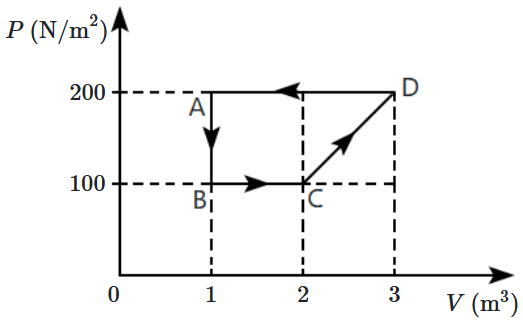One mole of a diatomic ideal gas undergoes a cyclic process \(ABC\) as shown in the figure. The process \(BC\) is adiabatic. The temperatures at \(A,\) \(B,\) and \(C\) are \(400\) K, \(800\) K, and \(600\) K respectively. Choose the correct statement:


| 1. | The change in internal energy in the process \(BC\) is \(-500R.\) |
| 2. | The change in internal energy in the whole cyclic process is \(250R.\) |
| 3. | The change in internal energy in the process \(CA\) is \(700R.\) |
| 4. | The change in internal energy in the process \(AB\) is \(-350R.\) |
Subtopic: Cyclic Process |
73%
Level 2: 60%+
Hints
One mole of an ideal gas is taken through a cyclic process as shown in the \((V\text-T)\) diagram. Which of the following statements is correct?


| 1. | The magnitude of the work done by the gas is \(RT_{0}\ln 2.\) |
| 2. | The work done by the gas is \(V_{0}T_{0}.\) |
| 3. | The net work done by the gas is zero. |
| 4. | The work done by the gas is \(2RT_{0}\ln2.\) |
Subtopic: Cyclic Process |
Level 3: 35%-60%
Hints
If \(Q\), \(E\), and \(W\) denote respectively the heat added, the change in internal energy, and the work done in a closed cycle process, then:
| 1. | \(W=0\) | 2. | \(Q=W=0\) |
| 3. | \(E=0\) | 4. | \(Q=0\) |
Subtopic: Cyclic Process |
79%
Level 2: 60%+
AIPMT - 2008
Hints
The heat energy absorbed by a system in going through a cyclic process shown in the figure is:


| 1. | \({10}^{3}\mathit{\pi}\) J | 2. | \({10}^{2}\mathit{\pi}\) J |
| 3. | \({10}^{4}\mathit{\pi}\) J | 4. | \({10}^{7}\mathit{\pi}\) J |
Subtopic: Cyclic Process |
71%
Level 2: 60%+
Please attempt this question first.
Hints
Please attempt this question first.
Refer to figure given below. Let \(ΔU_1\) and \(ΔU_2\) be the change in internal energy in processes \(A\) and \(B\) respectively, \(ΔQ\) be the net heat given to the system in process \(A + B\) and \(ΔW\) be the net work done by the system in the process \( A + B.\)
For the above figure:
| (a) | \(\Delta U_1+\Delta U_2=0\) |
| (b) | \(\Delta U_1-\Delta U_2=0\) |
| (c) | \(\Delta Q-\Delta W=0\) |
| (d) | \(\Delta Q+\Delta W=0\) |
Choose the correct option from the given ones:
| 1. | (a), (b) | 2. | (b), (c) |
| 3. | (c), (d) | 4. | (a), (c) |
Subtopic: Cyclic Process |
55%
Level 3: 35%-60%
Hints
A sample of an ideal gas is taken through the cyclic process \(ABCA\) as shown in the figure. It absorbs, \(40~\text{J}\) of heat during part \(AB\), no heat during \(BC\), and rejects \(60~\text{J}\) of heat during \(CA\). A work of \(50~\text{J}\) is done on the gas during part \(BC\). The internal energy of the gas at \(A\) is \(1560~\text{J}\). The work done by the gas during the part \(CA\) is:

1. \(20~\text{J}\)
2. \(30~\text{J}\)
3. \(-30~\text{J}\)
4. \(-60~\text{J}\)

1. \(20~\text{J}\)
2. \(30~\text{J}\)
3. \(-30~\text{J}\)
4. \(-60~\text{J}\)
Subtopic: Cyclic Process |
63%
Level 2: 60%+
JEE
Please attempt this question first.
Hints
Please attempt this question first.
The \((P\text-V)\) diagram of a gas system undergoing a cyclic process is shown in the given figure. The work done by the gas during isobaric compression is:

1. \(150~\text J\)
2. \(-200~\text J\)
3. \(-400~\text J\)
4. \(-250~\text J\)

1. \(150~\text J\)
2. \(-200~\text J\)
3. \(-400~\text J\)
4. \(-250~\text J\)
Subtopic: Cyclic Process |
59%
Level 3: 35%-60%
Please attempt this question first.
Hints
Please attempt this question first.





